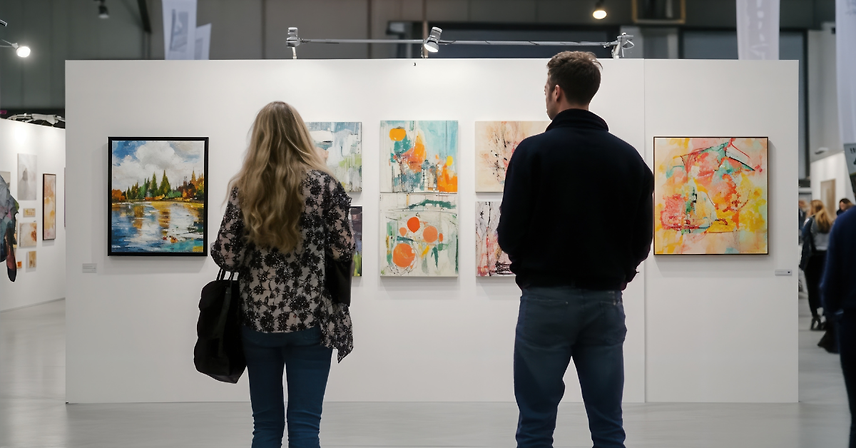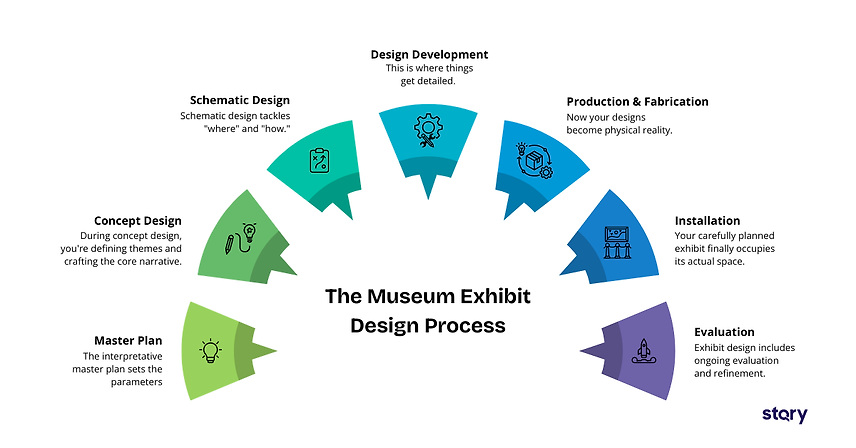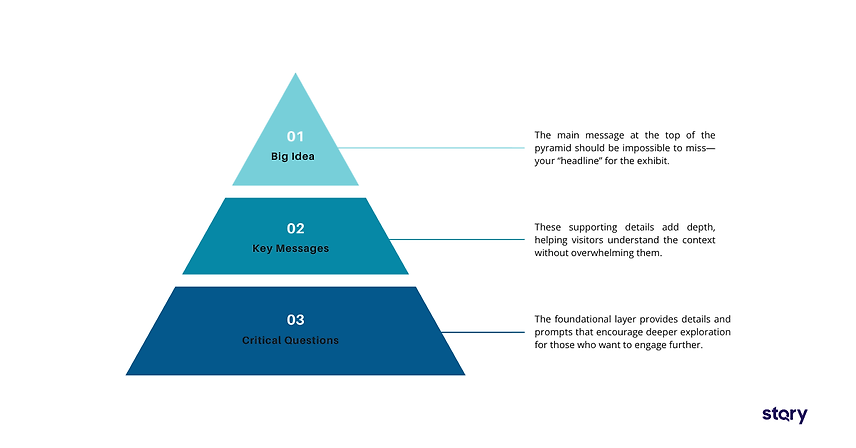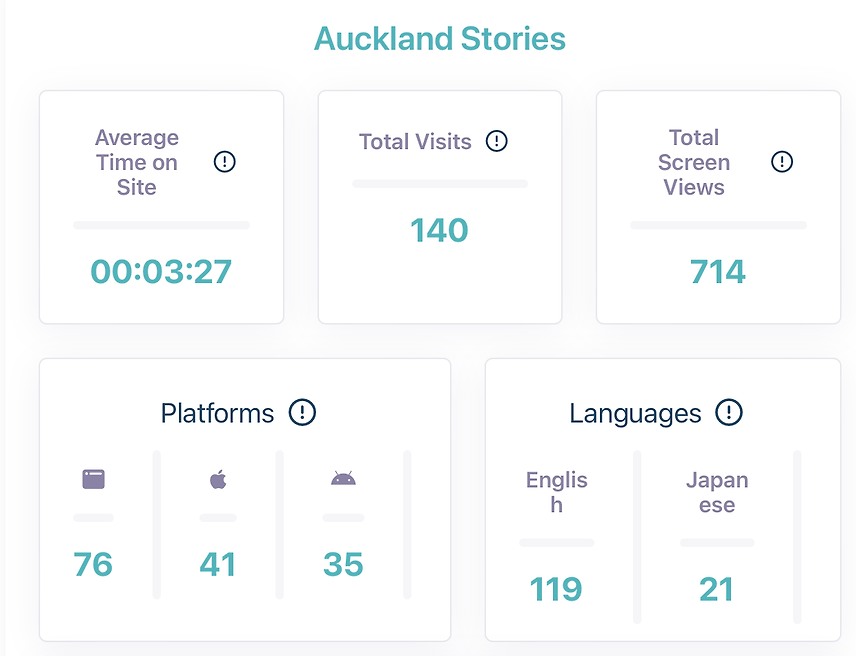
Digital transformation has fundamentally changed how people engage with cultural spaces. Museums now compete for attention with streaming services, social media, and immersive entertainment experiences.
The stakes? Making history, art, and culture feel alive again. If you're involved in museum exhibit design, you're facing an exciting challenge. How do you create exhibits that educate and captivate?
This guide walks you through the process of designing an engaging museum exhibit. It also highlights the latest trends shaping the industry.
Why Museum Exhibit Design Matters More Than Ever
Museum attendance has declined in recent years. Surveys indicate that nearly half of museums (49%) are still seeing lower visitor numbers, with a median attendance at 80% of pre-pandemic levels. Competition for people’s leisure time is also strong.
The good news is that thoughtfully designed exhibits can transform casual visitors into enthusiastic supporters.
Great exhibit design does three things simultaneously:
- It tells compelling stories.
- It respects the artifacts and their historical context.
- It creates memorable experiences that visitors talk about long after they leave.
The museums that thrive today understand this balance. They're not abandoning their educational mission. They're amplifying it through thoughtful, visitor-centered design.
The Museum Exhibit Design Development Team
The museum exhibit design team is a multidisciplinary group that brings an exhibit from concept to completion. They focus on creating experiences that are engaging, educational, and easy for all visitors to enjoy.

Client
The client sets the overall vision for the exhibit. They provide the institutional knowledge needed to understand the collection’s significance. They also communicate with key stakeholders throughout the project. In most cases, they oversee and manage the exhibit’s budget.
Curator
Curators bring deep scholarly expertise to an exhibit, ensuring accuracy and shaping the story being told. Their expertise often comes from specific fields, such as:
- Art Curators – art history, fine arts, or visual culture
- History Curators – history, archaeology, or anthropology
- Science Curators – natural history, biology, geology, or related sciences
- Special Collections / Rare Objects Curators – manuscripts, rare books, or archival materials
They combine research, conservation knowledge, and storytelling skills to make exhibits engaging and educational.
Project Manager
Project managers keep every aspect of the exhibit on track. They manage timelines, monitor budgets, and coordinate between multiple teams. This ensures designers, curators, fabricators, and stakeholders work together smoothly.
A project manager’s role is crucial for keeping the project organized, on schedule, and within budget.
Exhibit Developer
Exhibit developers turn curatorial vision into engaging, tangible experiences. They work with curators and designers to make exhibits both visually compelling and educational.
For example, they might transform a historical archive into an interactive display that brings the story to life for visitors.
Designer
Designers shape the look and layout of the exhibit, guiding visitors through the space. They highlight key artifacts and important messages. By working with curators, developers, and staff, they make the exhibit engaging and accessible.
Staff Members
Staff members offer invaluable insights since they interact with visitors daily. They know what questions people ask and where confusion typically happens.
Each role matters. Skip one, and you risk missing critical perspectives that make exhibits truly work.
The Museum Exhibit Design Process
Museum exhibit design follows a structured journey. Understanding each phase helps you allocate resources wisely and avoid costly revisions later.

1. Interpretative Master Plan
This is your foundation. Before anyone sketches a display case, you need clarity on the big picture. What stories will your museum tell? How do individual exhibits connect to broader institutional goals?
The interpretative master plan sets these parameters. It's strategic, looking years ahead at how your museum will evolve.
2. Concept Design
Now the creative work begins. During concept design, you're defining themes and crafting the core narrative. What's the "big idea" visitors should walk away with?
This phase involves creating mood boards that capture the emotional tone you're after. Storyboards help visualize the visitor journey from entrance to exit. Developing visitor personas ensures you're designing for real people, not abstract audiences.
Early feedback matters tremendously here. Share concepts with colleagues, potential visitors, and accessibility experts. Iteration at this stage is cheap compared to changes during fabrication.
3. Schematic Design
Concept design answered "what." Schematic design tackles "where" and "how." You're translating abstract ideas into spatial plans that visitors will physically move through.
Bubble diagrams map out major zones and how they connect. Visitor flow planning ensures people move intuitively through the space without bottlenecks or confusion. Rough 3D models help everyone visualize the exhibit in three dimensions.
Material choices start here too. Will you use sustainable materials? What about durability for high-traffic areas? These decisions impact both aesthetics and long-term maintenance.
4. Design Development
This is where things get detailed. Every graphic, every interactive element, every audio-visual component gets finalized. Technical documentation becomes crucial because fabricators need precise specifications.
Safety and accessibility aren't afterthoughts—they're central considerations. Can wheelchair users engage fully with interactive elements? Are lighting levels appropriate for artifact conservation? Do text sizes meet readability standards?
This phase produces fabrication-ready plans. The clearer your documentation, the smoother production will be.
5. Production & Fabrication
Now your designs become physical reality. You'll work closely with fabricators, AV vendors, and specialized builders. Each brings technical expertise to their domain.
Budget constraints get real during fabrication. You might need to make tough choices about where to splurge and where to simplify. The key is maintaining the design's integrity while staying financially responsible.
Communication matters enormously here. Regular check-ins prevent costly mistakes and ensure everyone stays aligned with the vision.
6. Installation
Installation is exciting and stressful in equal measure. Your carefully planned exhibit finally occupies its actual space. Lighting gets calibrated. Interactive elements get tested. Digital displays get fine-tuned.
Walk the visitor paths yourself. Do they feel intuitive? Are there sight-line issues you didn't catch in renderings? Small adjustments during installation can dramatically improve the final experience.
Testing functionality is non-negotiable. Every button, every screen, every sensor needs to work flawlessly before visitors arrive.
7. Evaluation
Opening day isn't the finish line. Effective exhibit design includes ongoing evaluation and refinement. How are visitors actually using the space? Where do they linger? Where do they rush through?
Analytics give hard data, like how long visitors stay, how they interact, and their movement patterns. Surveys provide feedback on what worked and what was confusing. This information is invaluable for improving future exhibits.
Key Principles of Effective Exhibit Design
Certain principles separate forgettable exhibits from unforgettable ones. Master these, and you're well on your way to creating compelling visitor experiences.
Storytelling Through Space
Museums are fundamentally about stories, told through space and objects. The interpretive hierarchy guides visitors through these narratives, just like headlines, subheadings, and body text in writing.

- Big Idea: The main message at the top of the pyramid should be impossible to miss—your “headline” for the exhibit.
- Key Messages: These supporting details add depth, helping visitors understand the context without overwhelming them.
- Critical Questions: The foundational layer provides details and prompts that encourage deeper exploration for those who want to engage further.
Narrative pacing matters. A well-designed exhibit balances moments of intensity with spaces to pause and reflect, creating a rhythm that keeps visitors engaged from start to finish.
Visitor Flow & Wayfinding
Effective wayfinding shows the path forward without heavy signage or confusing maps. To address this challenge, self-guided tour apps have become essential for modern institutions.
STQRY Apps makes creating these tours effortless with its no-code platform. Institutions can build fully functional tours within weeks, as the World of Wine (WOW) did, and even integrate the app with their ticket sales system.
Self-guided tour apps let institutions add important layers of interpretation and accessibility. Features like audio descriptions and text-to-speech create a more inclusive and engaging experience for all visitors.
For example, the STQRY app improved navigation at the Walt Disney Family Museum, making content far more accessible and easy to explore.
Our favorite features are the accessibility features, as we believe they add a much-needed new dimension to our existing content that makes the museum that much more accessible for everyone.
— Tracie Timmer, Senior Public Programs Coordinator at The Walt Disney Family Museum
Beyond navigation, self-guided tours turn passive signage into active, real-time guidance. This was demonstrated at the Savannah Book Festival, where targeted alerts streamlined the experience for thousands by sharing session times and capacity updates.
Museums can use the same approach to manage visitor flow. They can direct crowds away from busy exhibits and ease congestion.

Graphic Design & Interpretation
Labels and signage form the written voice of your exhibit, with hierarchy, font, size, and placement guiding readability. But interpretation goes beyond text. Museum kiosks now offer powerful ways to bring exhibits to life.
STQRY Kiosk provides a cutting-edge solution for museums to enhance engagement through videos, audio guides, and interactive quizzes. These technologies also make exhibitions more inclusive, with multiple language support, voice-over features, and braille options.
Consider the Papakura Museum in Auckland, where an interactive display on Ring's Redoubt showcases around 6,000 artifacts. Visitors can explore the collection in ways impossible with traditional labels, zooming in on details, hearing contextual stories, and understanding connections across the site.
This immersive approach helps visitors connect with history on a deeper level. Technology becomes the bridge between artifacts and understanding.
Visual Consistency
Your exhibit should feel cohesive. Colors, materials, typography, and graphic styles should work together to create a unified "look and feel."
Consistency doesn't mean boring. It means intentional. Every design choice reinforces the overall aesthetic and message.
When something breaks from the established pattern, it should be purposeful—drawing attention to something significant.
Conservation & Artifact Safety
Design and preservation must coexist. Beautiful displays mean nothing if they damage the objects they showcase.
Light levels need careful control. Temperature and humidity require monitoring. Display methods must protect against physical damage.
This constraint actually sparks creativity. How do you make artifacts visible and engaging while keeping them safe? The best solutions elegantly balance both imperatives.
Work closely with conservators throughout the design process. Their expertise prevents disasters and often inspires innovative approaches.
Trends Shaping Museum Exhibit Design
Museum exhibit design is changing fast. Static displays are giving way to interactive, inclusive, and multi-sensory experiences. This shift comes from rising visitor expectations, new digital technology, and a stronger push for social and educational relevance.
Immersive & Interactive Experiences
Interactive and immersive elements are transforming how visitors engage with exhibits. From touchscreens to fully immersive environments, the key is ensuring technology enhances the story rather than distracting from it.
Research shows that digital transformation technologies have revolutionized museum exhibitions and unlocked new possibilities for the future.
Tools like artificial intelligence, immersive experiences, additive manufacturing, the Internet of Things (IoT), and cloud computing help create engaging designs, improve accessibility and inclusivity, and enhance educational opportunities.
AR and VR
Augmented reality (AR) overlays digital information onto physical artifacts, while virtual reality (VR) can transport visitors to different times and places.
These technologies may sound futuristic, but they are becoming increasingly accessible. The real question isn’t whether to use them, but how to integrate them in a meaningful way.
A great example of AR in action is the SA National Parks Tours. One AR feature lets users explore a 3D model of Glenthorne House, which once stood proudly on the property.
In its prime, the house hosted lively events like picnics, jubilees, tug-of-war matches, and greasy pig contests. Though the house was destroyed by fire in 1932, the AR experience vividly brings its story and structure back to life.
STQRY is fully capable of creating more AR experiences like this to help museums and heritage sites bring history to life for visitors.
Modular and Sustainable Design
Modular systems allow sections of an exhibit to be refreshed or repurposed, extending exhibit lifespans and reducing costs.
Alongside this flexibility, sustainability considerations are becoming standard practice. Using eco‑friendly materials, energy‑efficient lighting, and long‑lasting designs helps museums operate more responsibly.
A survey found that 90% of museum visitors are concerned about climate change, and 81% believe museums should play a strong role in promoting sustainability.
Personalization & Data-Driven Journeys
Using visitor personas and analytics allows museums to understand audiences at unprecedented levels.
Modern analytics dashboards centralize metrics like session counts, location-based engagement, and visitor interactions. This gives you a clear, accessible overview of how exhibits perform in real-world use.
Data reveals patterns you might miss otherwise. Which interactive elements get ignored? Where do visitors spend the most time? What paths do they take through space? These insights inform future design decisions and help optimize current exhibits.
If your exhibit has a corresponding self-guided tour app or kiosks powered by STQRY, the STQRY Analytics Dashboard provides a comprehensive, real-time view of how visitors are interacting with your content.

Emotional Design and Affective Engagement
Facts inform, but emotions transform. The most memorable exhibits are designed for feelings as much as learning. What emotional journey should visitors take? How do you want them to feel in different spaces?
Color, lighting, pacing, and content all contribute to emotional impact. Some exhibits aim for awe. Others cultivate reflection or curiosity.
The best designs orchestrate these emotional notes intentionally, creating experiences that resonate long after the visit ends.
Sound and Sensory Layering
Museums are embracing multi-sensory design. Subtle soundscapes create an atmosphere without overwhelming. Textural elements invite touch where appropriate. Even scent can play a role in creating immersive environments.
Sound design deserves particular attention. The right audio can transport visitors to different contexts—imagine urban sounds in a city history exhibit or natural ambiance in an ecology gallery.
Silence matters too. Strategic use of quiet spaces gives visitors room to process and reflect.
FAQs
What are common museum display mistakes?
Some common museum display mistakes include overcrowding, poor lighting, and unclear wayfinding. In addition, inaccessible design can exclude visitors, and exhibits without interactivity may feel outdated and less engaging.
What type of art is in high demand now?
Contemporary art addressing social issues is popular. Interactive and immersive experiences attract crowds. Work by diverse or underrepresented artists is increasingly sought. Digital and new media art appeals to younger audiences. Local and community-focused art engages regional visitors.
What are the first five things to consider when planning an exhibition?
The first five things to consider when planning an exhibition are:
- Core message—what should visitors understand?
- Target audience—who are you designing for?
- Budget—what can you afford?
- Timeline and space—how much time and room do you have?
- Resources—what collections, expertise, or partnerships can you use?
How much does it cost to build an exhibit?
Exhibit costs depend on scale and complexity. On average, they range from $75 to $550 per square foot, depending on interactivity and finish. Simple interpretive exhibits typically cost $200–$350 per square foot, while tech-heavy, immersive experiences can exceed $1,200 per square foot. A standard “new exhibition” in an empty room usually runs around $200 per square foot, though costs rise with increased complexity and custom features.
Do museums pay artists to exhibit?
Costs and compensation depend on the institution and type of exhibition. Major museums typically pay artist fees for temporary shows, while emerging galleries may cover installation or promotion but not fees. Commercial galleries often take a commission on sales. Although many non-profits are moving toward fair compensation, practices still vary widely.
Power Your Museum Exhibit Design with STQRY
Great exhibits don’t happen by accident. They’re built through smart planning, meaningful storytelling, and the right technology. STQRY helps you bring all of this together.
Whether you want to create immersive digital layers, deliver accessible self-guided tours, or understand visitor behavior through real analytics, STQRY gives you the tools to design experiences that truly resonate.
You also get excellent customer support from a team that understands museums, digital storytelling, and the challenges that come with modern exhibit design.
Ready to elevate your next exhibition?